Greece › Mainland Greece Best Places
By Santorini Dave
See Also
- Where to Stay in Athens
- Where to Stay in Nafplio
- Where to Stay in Monemvasia
- Where to Stay in Thessaloniki
- Where to Stay in Delphi
- Where to Stay near the Meteora
- Where to Go in Peloponnese
- Where to Go in Halkidiki
The 12 Best Places to Visit in Mainland Greece
- Athens
Greece’s capital and perhaps the most important mainland destination; any trip to mainland Greece requires a stopover for at least a day or two.- Delphi
One of Greece’s best must-see archaeological sites; located in southern Greece, just across the Gulf of Corinth from the Peloponnese.- Ioannina
A bustling, picturesque lake town that’s the gateway to northwest Greece and the key to Epirus – the Zagoria villages, Metsovo, the Epirus Riviera (Parga, Preveza, Syvota).- Gytheio
A small but important port in the South Peloponnese that’s growing in popularity as a destination. Weekly ferry link to Kythira and Crete.- Kalambaka
The main outpost for visiting the incredible (and must-see) Meteora Monasteries, built on immense rocky pillars. Kalambaka also serves as an important transit link to the mid-north (Grevena, Kastoria, Kozani).- Kastoria
A beautiful lakeside town similar in style to Ioannina. Great for nature, skiing, and transit connections to Greece’s mid-north and northern border regions.- Monemvasia
Charming stone village on a small island off the east coast of the Peloponnese (but linked to the mainland by a short causeway). A magnet for painters, writers and readers.- Nafpaktos
A pretty, breezy, and historically important seaside town on on the north coast of the Gulf of Corinth.- Nafplio
Classy Peloponnese seaport retreat with neo-classical buildings and many excellent hotels.- Olympia
Along with Athens and Delphi, Olympia is one of of Greece’s three must-see archaeological sites. A small destination, but well situated for touring the west Peloponnese.- Thessaloniki
A strategic tourist travel position and airport hub in the central north, gateway to Greece for land arrivals from the Balkans and gateway to the Halkidiki peninsula.- Veria
A central and sizable northern town close to the Vergina and Pella archaeological sites, as well as the popular escarpment towns of Naousa and Serres.
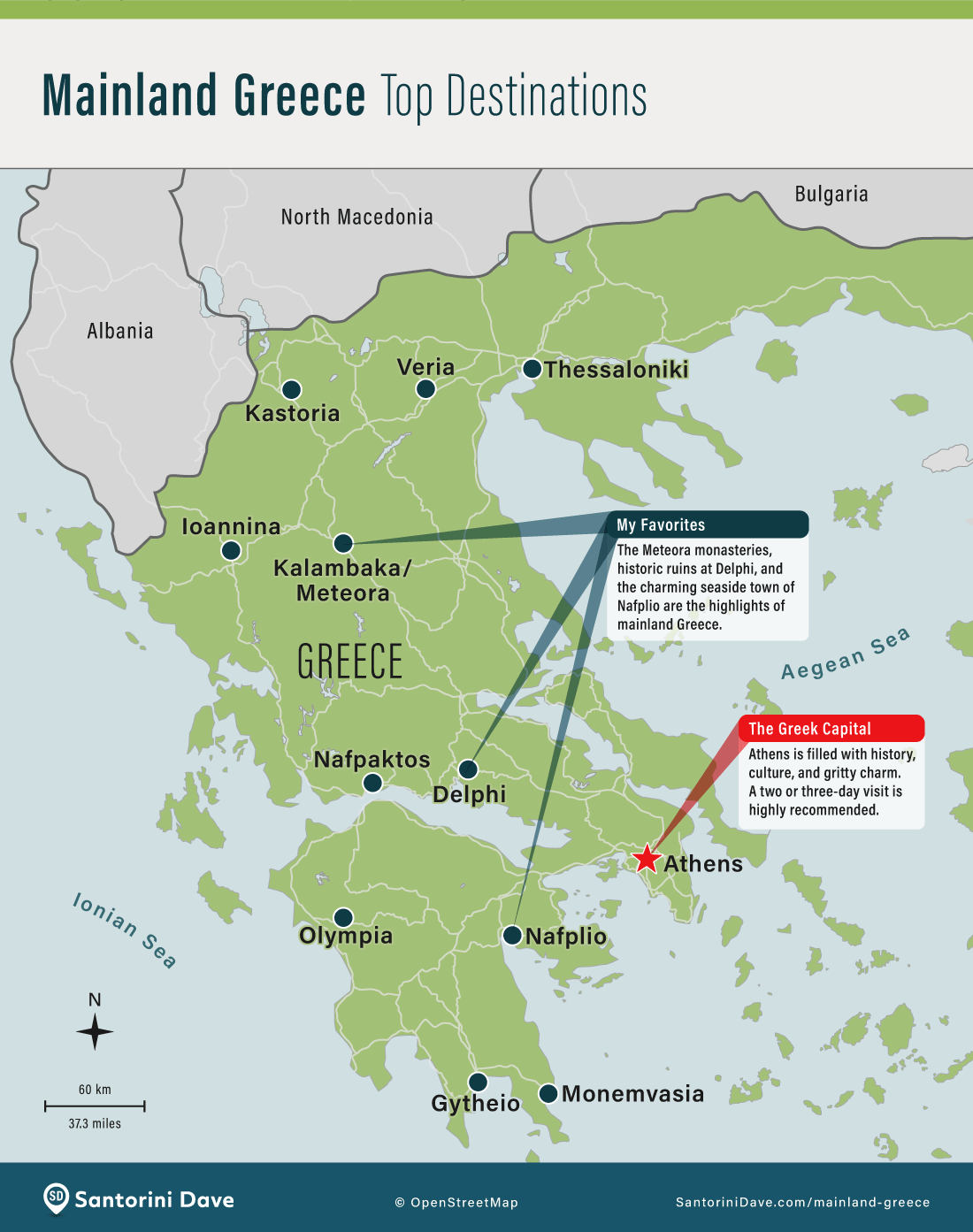
Athens
Athens is the nation’s capital and heartland, and an essential stop on any trip to the Greek mainland. Though it is a sprawling city of well over half a million, the city center is surprisingly small; all attractions listed here can be visited on foot. It’s also remarkably safe and welcoming, though it may appear chaotic and edgy at first. Athens is a great destination year-round, with the best times to visit being the spring and fall. It’s chilly (but relatively dry) in the winter months; midsummer sees the city emptying itself of locals, and can get unbearably hot. Allow for at least three nights in Athens, and stay as centrally as you can afford.
Things to Do in Athens
There are many great things to do in Athens, but if you have only 2-3 days, here are some of the highlights.
- Acropolis and Acropolis Museum: Athens is chock-a-block full of museums and ancient sites. If you must choose, then at least visit the Acropolis and the Parthenon Temple and its accompanying Acropolis Museum. • Map
- Concert at the Odeon of Herodes Atticus: If you plan to attend a concert in Athens, do it here. The atmosphere is electric. Check the Why Athens website for details of events during your visit. • Map
- Dining in Plaka or Psyri: A night out dining on the street is a must in Athens. The Plaka is touristy but has the location – right under the Acropolis. Psyri offers a more authentic experience. • Map: Plaka, Psyri
- Mount Lycabettus: For the highest and most spectacular views of Athens and the surrounding area, ascend to the summit of Lycabettus (Lykavittos) Hill. Take the cable car from the Kolonaki district, have lunch or a drink at the top then walk down. • Map
- The Changing of the Guard: It’s touristy, it’s a show, and it’s a shame not to see it. The Parliament building on Syntagma Square has two permanent Evzone Guards keeping watch, every hour on the hour, they swap places with new guards. Go on Sunday at 11am for the full show with elaborate costumes and a marching band. • Map
- Monastiraki Flea Market: Anything and everything can be bought in this chaotic bric-a-brac market that runs from Monastiraki Square westwards. Swords, vinyl records, coffee pots, and a thousand other items can be found here. • Map
Recommended Athens Hotels
- AthensWas Hotel – One of a growing number of small boutique hotels opening in Athens’ inner core. AthensWas combines style, finesse, and spacious comfort with the convenience of a central location. • +30 21 0924 9954 • Map
- New Hotel – A superbly renovated central downtown hotel two minutes’ walk from Syntagma Square. Great rooftop bar and restaurant. • +30 21 0327 3000 • Map
- Royal Olympic Hotel – Among the royalty of Athens’ classic luxury hotels, the ROH simply enjoys a stunning location. Panorama rooms are unparalleled for the views over the Temple of Olympian Zeus. • +30 21 0928 8400 • Map
Getting To and From Athens
As the capital of the country, Athens has the richest and widest choice of transport options in Greece. Offering air, rail, road, and sea links, travelers to Greece will almost inevitably pass through Athens at some stage of their itinerary.
Be advised that most areas in Greece, including Athens, have public transportation strikes throughout the year. These strikes can affect all forms of transit, including, buses, trains, ferries, flights, and taxis. During strikes no buses, no ferries, and only a handful of trains and flights will depart on time (or at all); taxis tend to be the least affected mode of transport. Though strikes can occur any time, there is always a huge strike on May 1. Avoid booking any ferries, flights, trains, or buses that day.
- Ferry: The Piraeus ferry port is about 10 km south of the city center and has direct ferries to most Greek islands (with the exception of the Ionian islands on the west coast of Greece). The most popular routes to Mykonos, Naxos, Paros, Santorini, and Crete have several sailings per day in high season.
- Air: Athens’ Eleftherios Venizelos Airport is a modern well-run establishment, with connections to all continents. The airport’s 35 km distance from the city center makes for a potentially costly transfer; options to reach the city are the bus, the metro, or taxi.
- Bus to/from Airport: The cheapest way to get into city center is the dedicated bus service that links the airport with the Kifissos bus station, the port of Piraeus, and the center. A bus ticket from the airport to Athens city center costs €6.
- Metro to/from Airport: The Athens Metro runs services to city center, Piraeus, and to Kiato in the Peloponnese. A metro ticket from the airport to central Athens costs €10.
- Taxi to/from Airport: A taxi from the airport to Athens’ city center will cost between €40 and €50. Taxis can be found outside the arrivals area. A good alternative is the Welcome Athens chauffeur service, which can be scheduled in advance.
Getting Around Athens
- Foot: Athens is not a large city to walk around if you stick to the city center. You can cover most of the major sites on foot – use your favorite maps app to guide you accordingly.
- Buses, Trolleys, Trams, and Metro: Athens’ urban transit service, while efficient, can be crowded and confusing to first-time users. Rechargeable, multi-use Athe.ena tickets can be purchased and recharged at all Athens transport ticket offices, as well as the automatic ticket issuing machines located at transit stops. They can be used to transfer from one mode of transport to another, and are chargeable for 90-minute, all-day, or 5-day increments. Specialized tourist tickets are available that include 1 round trip to/from the airport by Metro or Express Bus, and 3 days of unlimited travel on all other modes. Purchase these before boarding. As mentioned above, transportation strikes are commonly held on May 1 each year, so avoid booking major travel on that date.
- Taxi: Taxis are cheap here in comparison with the rest of Europe, but hailing one often involves stiff streetside competition with other ride seekers. Drivers will sometimes pick up multiple passengers who are heading in the same direction. A handy smartphone app called Beat is a neat way of getting the cab you want at a time you need one.
- Suburban train: A wider though still limited service that runs in parallel to some routes to the Metro. Its main difference is that it runs out as far as Corinth and Kiato on the north coast of the Peloponnese. Athe.ena tickets can be used for the urban section of this line.
- Train: Athens’ main rail hub, Larissa Station, is located 3 km from Syntagma Square, near the M2 line Metro station and reachable by the No 1 or No 790 bus. Another important station is the SKA (Railways Center of Acharnes), located near the Attiki Odos ring road and handy if you are taking the Airport Suburban Rail line to connect with a mainline train service.
- Car: while Athens may look undrivable, it is no worse than any other major city. With the use of a GPS device or Google Maps on your phone, navigating is not difficult. The easiest way to get out of Athens is to make for the toll road known as Attiki Odos and follow it: to the east for the airport, to the west for the Peloponnese and to the main north junction at Metamorfosi for the North. The freeway from Piraeus joins this same junction.
Delphi
Built next to a cleft in the mountains of Central Greece, with a stunning view to the sea far below, Delphi was thought by the ancients to be the center of the known world. Princes and paupers alike would journey to Delphi to seek counsel from the mystic Delphic Oracle; the ancient temples and adjacent (and enchanting) Greek village have drawn dreamers, philosophers, writers, and hopefuls ever since.
Today’s Delphi consists of an extensive archaeological site and museum, along with a couple of smaller, though not unimportant, classical offerings. Delphi village is a busy thoroughfare of two parallel streets crammed with quality hotels, restaurants, cafés and tourist shops. The center is compact and can be easily traversed in an hour or so. Delphi is worth at least a two-night stay to allow for a slow exploration of the Oracle site, and to soak up the still-present mystical atmosphere while watching the sunset over a panoramic dinner.
Things to Do in Delphi
- The Temple of Apollo: This sprawling hillside sanctuary is where the High Priestess (the Delphic Oracle) held court; visitors in antiquity came from far and wide to seek her prophesies. Today, it’s the prime reason visitors come to Delphi. Read up beforehand to understand what it was all about, and come early to avoid the heat and crowds. Entry is €12. • Map
- The Kastalian Spring and Sanctuary of Athena Pronaia: Of perhaps lesser interest, but interesting all the same, the former is the site of the spring where ritual purification took place. It is best enjoyed late at night or at sunrise. The latter is Delphi’s most famous landmark photo op site (the ruins with the columns in a circle); this would be the first stop by ancient visitors on their pilgrimage to the Sanctuary of Apollo. Map: Kastalian Spring, Sanctuary of Athena
- Delphi Archaeological Museum: The museum complements the Sanctuary site with model reconstructions, helpful historical information, and important artifacts from the site. Visit the museum first to gain context (go early – or late afternoon – to avoid the crowds), and head to the Sanctuary afterward. Your €12 ticket covers both entry fees. • Map
Recommended Delphi Hotels
- Kastalia Boutique Hotel – An airy and friendly establishment with exceptionally comfortable rooms and mind-blowing views. An in-house restaurant and panoramic terrace make for an all-inclusive package. • +30 22 6508 2205 • Map
- Amalia Hotel – A sprawling hotel set in the hillside just outside of town, with an on-site restaurant and large outdoor swimming pool. • +30 2265 082101 • Map
- Acropole Delphi Hotel – Cozy, folksy lodging just below the main street in a quieter part of the village. Unparalleled views out over the valley below. • +30 22 6508 2675 • Map
Getting To and From Delphi
The most common forms of visitor transport to and from Delphi are bus tours and private vehicles. The only other way in and out is by bus.
- Bus: The main bus route runs back and forth from Athens, leaving Athens from Bus Station B at Liosion. Buses are plentiful along this route, and details are easier to follow at the Fokida KTEL Bus Station website. Travelers wishing to travel from Delphi to Meteora or Olympia will have to make at least one transfer: For Olympia, take a Patra-bound bus (change in Itea on the same ticket). In Patra walk 550m northeast from the arrival bus terminal on the port (corner Gerokostopoulou and Othonos & Amalias) to the Pyrgos bus station. From Pyrgos take a local bus or train to Olympia (see Olympia entry).
For Meteora, take a bus to Amfissa (via Itea) and swap for a bus to Lamia. From Lamia you can either train it (from Leianokladi) to Kalambaka, or bus it via Trikala.- Taxis: Though the village center is easily traversed on foot, taxis can be helpful in getting to some Delphi’s more distant attraction. They congregate opposite the bus stop at the eastern edge of the village. • Tel: +32 22 6508 2752
- Be advised that most areas in Greece, including Delphi, have public transportation strikes throughout the year. These strikes affect all forms of transit, including, buses, trains, ferries, flights, and taxis. Though strikes can occur any time, there is always a huge strike on May 1. Avoid booking any major bus, train, or ferry trips that day.
Ioannina
Ioannina is the bustling mountain capital of the northwest Greek region of Greece known as Epirus. Think of it as Greece’s Scotland – with soaring, stunning mountains, and a lake with its own inhabited island. Linger and relax with an ouzo on ice by the lakefront, or take a slow boat ride to the Island for a meal of eels, trout, or even frogs legs.
Ioannina has had a checkered past, from its founding in the Byzantine Empire in the 6th century AD, through the Ottomans and a bloodthirsty dictator. Today it is an important university town with a lively student café scene. It features a Turkish-inspired Old Town and walled ‘Kastro’ and is the gateway to Epirus’ little known Zagorochoria villages that seem to be straight out of Grimm’s, with fairytale stone houses, stone bridges over rushing rivers, and the awe-inspiring Vikos Gorge (the deepest in the world).
Things to Do in Ioannina
- The Island:The only lake-island in Greece where people live all year round. It consists of a compact village, a monastery, and a shaded walking path around the island. It is home to the Ali Pasha Museum, dedicated to Ioannina’s infamous Ottoman-Albanian despot who ruled with an iron and often vicious hand. A passenger ferry boat leaves from the waterfront by the Kastro every 20 minutes. • Map
- The Castle/Kastro: More a walled mini-city than a castle the ‘Kastro’ consists of a living community, some small hotels, a large Byzantine museum, and a former mosque. Cobbled streets meander at will, but you will never get lost. • Map
- The Lake: No tour boats explore the vast green expanse of Lake Pamvotis, but cyclists can circumnavigate the Lake in about an hour and a half (24 km) on quiet rural lanes, a lakeside road, and a dedicated cycle path near the town itself. • Map
- Zagori Villages and Vikos Gorge: A 45-minute drive to the northeast of Ioannina leads visitors to the stunning scenery and topography of these two chart-topping sights. Don’t miss the awe-inspiring sight of Vikos Gorge from Monodendri. Take in a sophisticated rural lunch in the villages of Papingo or Mikro Papingo. Map: Zagori, Vikos Gorge
Recommended Ioannina Hotels
- Saz City Life Hotel – Re-purposed from tired inner-city office buildings, Saz offers trendy urban accommodation in the heart of Ioannina. • +30 26 5107 8888 • Map
- Guesthouse Politia – One of the forerunners of the boutique studios scene, this cozy space occupies choice real estate in the Old Town. • +30 26 5102 2235 • Map
- Villa Vilielmini – Less a hotel and more luxury apartments, Villa Vilielmini enjoys a location close to the lakefront and its café scene. • +30 26 5103 0515 • Map
Getting To and From Ioannina
Travel to and from Ioannina has been difficult in the past, with air connectivity only to Athens and road transport slowed down by tortuous access routes and the town’s mountain setting. Since the opening of the Ionian Way (south) and the Via Egnatia (east-west), however, road transport to Ioannina is super fast and in 2018 Ioannina opened up international air links with flights to Europe and the Middle East.
- Bus: Ioannina’s busy bus terminal is located by the lakeside at Georgiou Papandreou 45; the KTEL bus website is rather clunky and ageing, but is at least offered in English. Connections are pretty well spread across the country you can even take a bus to Chania in Crete.
- Air: Air links are mostly still with Athens, but charter companies from places such as Sweden and Israel have recently started flying into Ioannina. The King Pyrros Airport is 4.5 km northwest of the town.
- Taxi: Order a local taxi by calling +30 26 5104 6777.
- As with Athens and Delphi, Ioannina is subject to Greece’s public transportation strikes throughout the year, but especially on May 1. Avoid scheduling any flights or buses that day.
Gytheio
Gytheio is a pretty, laid-back port town with an enticing and genuine Greek atmosphere that’s rare among Greek tourist ports these days. Once the port of Ancient Sparta, Gytheio is now the de facto ‘capital’ of the Laconian Mani region of the Mani Peninsula and primarily makes its living from fishing. Cafés and restaurants line its waterfront where a recently established pedestrian walkway allows for ambling and chatting before dinner. A small islet offshore adds to the mix, while south of the village a long sandy beach provides for swimming and sun-baking. Gytheio also serves as a primary contact point between the Greek mainland and Crete, with options to visit the islands of Kythira and Antikythira in between. Gytheio’s friendly and sunny disposition makes it an excellent choice for a casual sojourn for two to four days while touring the area or while waiting for the boat to Crete.
Things to Do in Gytheio
- Marathonisi Islet: Said to be the ancient Cranae where Helen and Paris of Troy consummated their affair, thus irresponsibly starting the Trojan War. Today called Marathonisi, which means ‘fennel island’, this long, cigar-shaped islet features a lighthouse and a small tower, and is linked to Gytheio by a narrow walkway – perfect for a sunset stroll. • Map
- The Mani Peninsula: The Mani is the central finger-like peninsula of the Peloponnese and wild both in topography and its people, who are known to be stubbornly and proudly independent. Travel writer Patrick Leigh Fermor was inspired by this region to write his ‘Travels in the Southern Peloponnese;’ he settled and lived in Kardamyli in Messinian Mani. Travel slowly and take in the textures and subtleties of the region. • Map
Recommended Gytheio Hotels
- Olive Yard Boutique Hotel – This small guest hotel north of central Gytheio offers a graceful and relaxing rural space to unwind and watch the sun go down. • +30 27 3302 9210 • Map
- Saga Pension – Directly over the best restaurant in town, in central Gytheio, right next to the port. • +30 27 3302 3220 • Map
- Mareggio – Fresh and modern beachfront suites and residences (some with private pools), 5 minutes north of town. • +30 27 3302 1113 • Map
Getting To and From Gytheio
Gytheio is an outpost, end-of-line destination, linked indirectly by bus to most Peloponnese destinations – typically via Sparti. It also has a little known and useful car ferry to Kissamos in Crete.
- Bus: The bus stop and ticketing agency is near the junction of Ermou and Vasileos Georgiou, a 650 m hike to the waterfront.
- Ferry: The car ferry Ionis makes a weekly run to and from Kissamos in Crete, though booking tickets online is next to impossible. See Rozakis Shipping Agency (Vasileos Pavlou 5, tel: +30 27 3302 2207) on the waterfront for bookings.
- Taxi: To get around by taxi call English-speaking Canadian-Greek Angeliki (tel: +30 69 4543 8209) for all the local gossip and lore as well a good way to get to local attractions.
- As mentioned above, Gytheio is subject to the public transportation strikes held throughout the year, with the largest taking place every May 1. Avoid scheduling any buses or ferries that day.
Meteora (Kalambaka)
The bright and cheery rural town of Kalambaka is the jumping-off point for visits to the soaring, suspended monasteries of Meteora. These monasteries grew out of a desire for prayerful isloation and the necessity for self-preservation, used by late Byzantine monks and hermits as a refuge and hideout against Ottoman incursions. Over the years, the monastery buildings grew organically and are now quite impressive in their size and appearance. Travelers can spot the tall sandstone pinnacles from afar as they rise unexpectedly from the surrounding plain, and the effect only gets more startling as you draw closer.
The smaller settlement of Kastraki – a 15-minute walk west – is actually the heart of the Meteora monasteries and a more charming area to stay, though you can easily access the monasteries via a foot trail from the northern end of Kalambaka itself. While the bulk of visitors come for the monasteries, more athletic visitors come to climb the pinnacles themselves. The Kalambaka-Kastraki combination is a pretty destination package in itself with enticing restaurants, rustic wood and stone hostelries, and a vibrant atmosphere worthy of a day or three of lingering. The area is also an important transit point for travelers to Epirus or Western Macedonia. A winding 36 km road north leads to the junction with the Via Egnatia, where travelers can turn west for Ioannina or East for Kozani and Kastoria.
Things to Do in Kalambaka
- The Meteora Monasteries: There are six major monasteries worth visiting, but unless you are a walker, or really like monasteries, you are better advised to stick with just two or three. Ideally, you will need transport to get around. The Great Meteoron is the biggest and most well-known. Start with that and choose another one or two based on proximity, or love of hiking. A small charge is levied to visit each monastery, and a strict dress code is enforced.
- Rock Climbing: You will inevitably spot specks of red, yellow and other visible colors edging their way up the vertical rock walls. These are real people doing what they love: climbing. If you climb, Meteora offers some serious challenges, and ClimbGreece can help you out.
- Hiking: You can enjoy Meteora without the need to actually visit the monasteries by hiking along a pretty well-defined series of hiking trails. Visit Meteora offers some excellent hiking and sightseeing tours.
Recommended Kalambaka Hotels
- Hotel Doupiani House – Beautiful old-world retreat in Kastraki with a classy bar and fireplace lounge, plus a stone garden terrace with amazing views. • +30 2432 077555 • Map
- Tsikeli Hotel – Eco-friendly and adults-only, this stylish hotel in Kastraki offers e-bike rental and rooms with hot tubs or saunas. • +30 2432 022438 • Map
- Divani Meteora Hotel – Kalambaka’s more upscale traditional hotel. It offers an airy, modern interior and two swimming pools – one indoors, one in a lovely garden. • +30 24 3202 3330 • Map
Getting To and From Kalambaka
Kalambaka is a popular entry point for the monasteries of Meteora and is linked by rail and bus.
- Car: Travelers with cars are advised that the access route from the Via Egnatia to the north is a slow and winding route with many turns and bends – it may not suit people prone to motion sickness.
- Bus: The centrally located Kalambaka bus station (a simple street corner affair) is a subsidiary to the larger and modern Trikala bus terminal, 23 km away. Most ongoing services will involve a change of bus at Trikala. Trikala is linked to the most important mainland destinations. It takes about 6 hours to get from Athens to Kalambaka by bus (including the bus change in Trikala).
- Train: Kalambaka also boasts a train station with most services terminating at Paleofarsalos, where travelers can change trains for Thessaloniki or Athens, though there is one daily direct to/from service between Kalambaka and Athens (which takes just under 5 hours).
- Taxi: Call a local taxi at +30 24 3202 2310.
- Like all major towns in Greece, Meteora (Kalambaka) holds annual public transportation strikes on May 1 and various dates througout the year. Avoid booking trains, buses, or any major travel on that day.
Kastoria
Kastoria is a pretty and picturesque town in western Macedonia that perhaps doesn’t receive as many international visitors as it deserves. Similar in many ways to its cousin Ioannina to the southwest, Kastoria features a large lake, as well as a prominent peninsula that juts out into the lake and upon which the Old Town is built. It is renowned for its serenity, beautiful nature, and skiing, with dappled mountain ranges and some of the best old mansion accommodation in the north. Very popular with domestic Greek travelers, Kastoria built its wealth on the fur trade and is still a major sale center for fur coats and fur products.
Kastoria is not on any major thoroughfare but can be comfortably reached with an easy 40-minute drive off the cross-country Via Egnatia to the south.
Things to Do in Kastoria
- Old Kastoria: Kastoria’s Old Town is focussed on the Doltso neighborhood, a labyrinthine collection of winding streets and imposing merchant mansions. Wandering this compact area, you will admire some very impressive old buildings, several of which have been turned into hotels for visitors. • Map
- Byzantine Museum: This impressive collection of Byzantine art and religious exhibits is worth an hour or two of study. Easy to find on Plateia Dexaminis in the center of the Old Town. • Map
- Cycling: The lake provides for a perfect circumnavigation on two wheels. O Podilatis hires out all kinds of bikes from serious to leisurely. The two and four seaters are great for fun with a group – and everyone gets to pedal. • Map
- Nestorio River Festival: Rock your socks off at this annual music fest by the river. Now into its 40th year, this five-day rockathon features contemporary and traditional Greek music. It takes place towards the end of July and you can camp. Buses take you there and back from Kastoria. • Map
- Arcturos Bear Sanctuary: Bears and other wild creatures have existed in this area for centuries, but have not always been appreciated. Located 37 km northeast of Kastoria, this wildlife sanctuary is worth a visit. Stop in the attractive nearby village of Nymfaio for lunch, or even to stay the night. • Map
Recommended Kastoria Hotels
- Hotel Doltso – The best of Kastoria’s old town lodgings. Grandiose décor in a pleasing neutral palette. Cozy, comforting, and calming luxury dressed in stone. • +30 24 6702 2022 • Map
- Orologopoulos Mansion – This is another popular and spacious choice in old Kastoria. Tradition and luxury blend seamlessly in this striking looking building. • +30 24 6702 1604 • Map
- Vergoula’s Mansion – Traditional house offering old style comfort, lovingly renewed. Very convenient location in the Old Quarter. • +30 24 6702 3415 • Map
Getting To and From Kastoria
- Car: Kastoria is a little bit ‘out on the edge’ and not on any major road routes, so it really lends itself to being visited by car – especially if you wish to see some of the surrounding countryside and make excursions to sights in western Macedonia.
- Bus: Nonetheless, it has a good intercity bus network and a centrally located bus station. Check the KTEL website for timetables. Kastoria is directly linked by bus to Thessaloniki, Athens, Volos, Kozani and Ioannina.
- Air: Kastoria is linked by air to Athens via Kozani with Astra Airlines.
- Taxi: Call a local taxi at +30 24 6702 1222.
- Avoid booking flights or buses on May 1, when the annual public transportation strike takes place.
Monemvasia
A Byzantine fortress town on the southeastern coast of Laconia. Dubbed Greece’s Gibraltar due to its location on the base of a large rock rising from the sea, Monemvasia is quite unique in Greece – a medeival village of picturesque cobbled streets and lovingly restored stone houses.
In existence since the 6th Century AD, Monemvasia served as a refuge from mainland invasions (when it was still disconnected from the mainland) and later developed into an important trade and maritime center. Passed from the Franks to the Venetians and the Ottomans and finally to the Greek State after the War of Independence (1821), the village languished in relative obscurity in later years. Recently ‘discovered’ by curious travelers, Monemvasia is now a magnet for painters, writers, and readers – one of Monemvasia’s more famous sons is the Greek poet Yannis Ritsos who was born and lived in the village, and is now interred in the cemetery there.
Things to Do in Monemvasia
- The Kastro: The best thing to do in Monemvasia is amble aimlessly along its Byzantine tangle of alleyways and back streets. The historic village is peppered with little churches, squares, and small restaurants and cafés. • Map
- Upper Town: From the heart of the village you can walk up to the ruins of Upper Town, now abandoned but once the site of the settlement’s grandest homes and churches – including beautiful Hagia Sophia. Picture-perfect views over the roofs of the houses out to sea make the strenuous climb worthwhile. • Map
- Yannis Ritsos’ Home: Of interest to poets and the literary-minded, Ritsos’ House is located at the beginning of the village just after the entry gate. Monemvasia’s most famous son, this iconoclastic left wing bard fought dictatorships with words. • Map
Recommended Monemvasia Hotels
- Kinsterna Hotel – 5-star luxury estate with gardens, vineyards, olive groves, and stables. 10 minutes south of the castle. • +30 27 3206 6300 • Map
- Moni Emvasis Luxury Suites – The best of the romantic and historic castle properties, close to the gate and with excellent views. • +30 27 3206 2122 • Map
- Likinia Hotel – A newly-built but traditionally-styled hotel in the Old Town of Monemvasia. Rooms and suites have sea views and cooling sea breezes. • +30 27 3206 1939 • Map
Getting To and From Monemvasia
Because it is a somewhat remote outpost status, Monemvasia is not such an easy place to visit on public transport.
- Bus: There are buses from Athens, but a bus trip to Momenvasia will likely involve a change in Sparti or Molai. The KTEL Lakonia website goes some way to explaining the links. There are three daily services from Athens and four vice versa. Buses arrive at and leave from Gefyra across the causeway; hike from there to the entrance of Monemvasia, or take the shuttle bus that runs every 30 minutes from Gefyra to Monemvasia. Bus tickets can be obtained from Malvasia Travel in Gefyra. As with all other destinations mentioned, avoid taking public transportation to Monemvasia during the annual strike on May 1.
- Taxi: Arrivals from Kythira to the Peloponnese port of Neapoli are advised to seek a taxi (approx. €40) to Monemvasia. Call +30 69 3247 6486 (Minas Papoulis) or +30 69 7727 5414 (Ioannis Dertilis) or +30 69 7415 6097 (Georgios Minopetros) to arrange for a taxi to meet the incoming ferry.
Nafpaktos
Nafpaktos is a pretty, breezy, seaside town in the mostly overlooked mainland corner of Central Greece. A relaxing locale with a totally unpretentious Greek air, it’s worthy of a day or two of traveler time if heading out the little-known region of Greece known as Aitolo-Akarnania.
A famous naval battle was once waged here between the Ottomans and a tri-part alliance of the Vatican, Spain, and Venice; today the town is a thriving and non-touristy seaside community with a postcard-pretty harbor full with restaurants and cafés. Nafpaktos is conveniently located halfway between Delphi and Olympia, making for a very convenient break between the two. Top class boutique accommodation rounds off the attraction.
Things to Do in Nafpaktos
- The Harbor: Sitting at a café in this small and lovely harbor with its protective stone wall – sipping an iced frappé, or nursing an ouzo on ice – is a slow and unchallenging activity that nonetheless makes up a big part of the Nafpaktos scene. • Map
- Nafpaktos Castle: It is a bit of a strength-sapping hike up to the Kastro, but like all walks that involve an uphill climb for an hour or so, the view pays for the effort. The Kastro is in decent condition and its fortifications date back to Doric times. • Map
- Fethiye Mosque: Built by Sultan Bayezid II when he ruled the Ottoman Empire, this splendid mosque still stands and is open to the public. Exhibitions are held here in summer. • Map
- Botsaris Tower Museum: This gray-painted tower near the harbor, named after Souliot General Notis Botsaris, houses a small museum with paintings and engravings relating to the Battle of Lepanto. • Map
- The Nafpaktia Hinterland: Nafpaktos sits at the southern tip of a largely unknown and little-explored mountainous chunk of central Greece where a lot of outdoor activity takes place. A list of some of activities runs as follows: kayaking, climbing, hiking, rafting and paintballing. Driving north with a 4×4 to Karpenisi is a great eye-opener to another Greece. • Map
Recommended Nafpaktos Hotels
- Apollon Library Suites – A modern concept hotel where the theme is artful reading. Twelve lovingly finished suites are fitted out in earthy textures and feature mini-libraries for guests. • +30 26 3403 8615 • Map
- Arhontiko Pepos – Occupying prime position in the pedestrian zone next to the harbour, Pepos is a sophisticated and elegant guesthouse with five tasteful element-themed rooms. • +30 26 3403 8185 • Map
- Hotel Akti – The exterior belies the interior in this affordable accommodation choice. Rich furnishing and lush lounges dominate while rooms are all tastefully appointed. • +30 26 3402 8464 • Map
Getting To and From Nafpaktos
Nafpaktos is on the main highway linking towns along the northern Gulf of the Peloponnese and is easily visited by travellers moving between Olympia and Delphi. (Travelers to Delphi will normally swap buses in the port of Itea.)
Nafpaktos’ brand new KTEL bus station is unhelpfully located outside of the main town area, so you will need to take a cab (tel: +30 26 3402 5111) to/from the town center. Avoid bus travel on May 1, during the annual public transportation strike.Nafplio
Nafplio is a classy weekend retreat or day trip from Athens for Greeks and travelers looking for a chic getaway close to the capital. Neo-classical and Venetian mansions, polished stone alleyways and thoroughfares, a couple of fortresses, beaches, quality hotels, and a picturesque harbor combine with fashion, gourmet food, and distinguished wines to create a winning destination in one of Greece’s most popular towns – all within easy driving distance to the significant archaeological attractions of the region such as Mycenae, Tiryns, and Epidaurus.
Appointed Greek capital for one year after the liberation of Greece in 1821, Nafplio’s role as head city was passed over to Athens by Greece’s first King, Otto. That didn’t deter Nafplio from slowly developing into a swanky retreat for urbanites, artists, merchants and other posh people in later years. Today’s travelers are advised to make plans well in advance. Its gorgeous and sophisticated air ensures there are many visitors year-round – particularly in winter, though high summer sees a lot of northern Europeans drawn by its irresistible pull.
Things to Do in Nafplio
- The Old Town: Nafplio’s primary attraction is the inimitable ambiance and taste of the streets of the traditional quarter. It invites strolling, browsing, shopping, eating, dining, seeing and being seen. Simple as that. • Map
- The Palamidi Fortress: Guarding the eastern flank of Nafplio town this enormous citadel can be approached by a steep climb, or a rather roundabout (but easier) drive. Go early if you plan to walk. It’s almost 1000 steps to the top. • Map
- The Bourtzi: Viewable from any part of Nafplio, this mini Venetian fortress sits asea and guards the harbour. Once a prison, it now accepts visitors by tour boat. • Map
- Archaeological Museum: This museum traces the history of the Argolis peninsula from its earliest days – well worth a pre-lunch, enlightening meander. • Map
- Akronafplia Fortress: Looming above the town is the unavoidable hulk of this immense natural bastion. Drive, walk or take the lift that’s located in the square near the “Five Brothers” cannons: it’s worth it for the views. • Map
- Komboloi Museum: Teeny tiny museum dedicated to komboloi; the traditional worry beads that Nafplio is particularly known for creating. Located upstairs of a small storefront in Old Town – you can buy your own on your way out. • Map
Recommended Nafplio Hotels
- Gambello Luxury Rooms – Utterly charming 11-room boutique hotel in a neoclassical mansion near the Nafplio harbor and waterfront promenade. Excellent views of Bourtzi fortress from some rooms. • +30 2752 023009 • Map
- 3Sixty Hotel & Suites – Cousin to the Ippoliti Hotel, the funky and elegant 3Sixty offers a modern twist on comfort and hosts a renowned gourmet restaurant. • +30 27 5250 0501 • Map
- Regno di Morea – Modern boutique hotel in the heart of Old Town Nafplio. • +30 27 5202 2232 • Map
Getting To and From Nafplio
Nafplio is connected to the rest of Greece by bus only, covered by the Argolis KTEL network. There are between 11 and 14 direct connections with Athens, as well as one or two services between other major Peloponnese towns such as Kalamata, Tripoli, and Patra.
The bus terminal is on Andrea Syngrou on the eastern side of the Old Town where there is also a handy taxi stand. (Call +30 27 5202 6300 or get the app to arrange a taxi in advance.) Avoid taking public transportation on May 1, when most buses, trains, ferries, and flights are stopped.
Olympia
This pleasant, bucolic village in the northwestern Peloponnese is ancient birthplace of the Olympic Games, worth a day or two of traveling time in any trip to Mainland Greece. Olympia is a pleasant place to linger; there is a relaxed ambiance, fine dining, friendly cafés, and feeling that you are at one – if only for a day – with the principles of global harmony promoted by the games for centuries.
Things to Do in Olympia
- Ancient Olympia: See where the Olympic movement started, including the spot where the Olympic flame is lit every two years. The site is enormous and requires some time to see. Start early to avoid the throngs of cruise ship travelers that arrive by bus and train by mid-morning, and read up (or visit the Archaeological Museum) in advance, so you know what’s what. • Map
- Archaeological Museum: Complementing the site itself is this impressive museum that features finds from the site of Ancient Olympia. It is advised to visit here on a separate day as the site itself, as there is a lot on display to absorb. • Map
- Museum of the History of the Olympic Games in Antiquity: A separate museum exhibition, this collection focuses on the Games themselves and is best combined on the day with the Archaeological Museum. Entry is on the same ticket as the Ancient Olympia site. • Map
Recommended Olympia Hotels
- Hotel Europa – A grand resort style hotel with a pool and excellent outdoor restaurant. You’ll need a cab to get here as it’s a little outside Olympia village, but worth the effort. • +30 26 2402 2650 • Map
- Hotel Pelops – A more modest accommodation option for visitors to the village; a small family hotel with all the necessary comforts and a welcoming atmosphere. • +30 26 2402 2543 • Map
- Central Guest Room – Conveniently-located double rooms & apartments with balconies. • +30 69 3690 7066 • Map
Getting To and From Olympia
Olympia is not particularly well-connected by public transport to any major destinations, though there are a couple of options to choose from, traveling through Pyrgos.
- Bus: Olympia is accessible via local bus from the main Pyrgos bus station to Olympia. There are thirteen daily departures, and the trip takes about 45 minutes. Buses leave from platform 1.
- Train: There is a very good modern train service that links Olympia with the port of Katakolo, via Pyrgos. There are three departures daily from Pyrgos.
- Taxi: Taxis in Olympia depart from the train station.
- Avoid taking the bus or train on May 1, when the yearly public transportation strike takes place.
Thessaloniki
Thessaloniki’s maritime location makes the second-largest city in Greece seem less like a commercial center than a breezy seaside resort. A smoother sibling city to Athens down south, Thessaloniki is immediately likable; the pace is more relaxed and the air seems somehow brighter here. Many great hotels too.
An ancient city by any standards (founded in 315 BC), Thessaloniki wears its checkered and multi-cultural past with panache and pride. It was the second-largest and wealthiest city in the Byzantine Empire, home to a large Jewish community under the Ottomans, and became part of the Greek State in 1912. It is now considered to be the cultural capital of Greece, and many would also say culinary capital too – some of the country’s finest dining can be enjoyed here. Fashionistas will find some of the trendiest items of apparel on its chic streets.
Things to Do in Thessaloniki
Like Athens, there is enough to see in Thessaloniki to keep you occupied for weeks. If you’ve only got two to three days at your disposal, here are some of the must-dos: the best and easiest Thessaloniki attractions and experiences.
- Archaeological Museum: History buffs will love to browse among this elegant collection of ancient Macedonian and Hellenistic finds from the area. The Vergina Tombs exhibits are located in Vergina (see Veria section). • Map
- Boat Cruise: Take a free evening boat ride around the waterfront bay and enjoy the lights of the city from the sea. Just buy a drink on board – that’s your ticket (or €3 if you don’t want to order anything). One of Thessaloniki’s best-kept tourist secrets. Look for the boats near the White Tower. • Map
- Ladadika Quarter: This once tumbled-down industrial district has been the home in recent years to some of the city’s best dining surprises. Buttressing the north-western flank of the waterside, Ladadika is a great place for a drink or for schmoozing around on foot for an hour or two. • Map
- Shopping: the eastern end of Tsimiski Street hosts a dazzling array of fashion outlets and shoe boutiques. Greece’s latest fashions are debuted here and prices are brilliant – especially during the sales season. • Map
- The Kastro: backing the modern city are the walls of the Kastro that today constitute the Ano Poli (Upper City). It’s cooler up here and walking its walled streets peppered with battlements and monasteries makes a nice escape from the city, as well as a great spot for a sunset dinner. • Map
- The White Tower: The ultimate symbol of Thessaloniki, all of the city revolves around this unmistakable landmark. Despite its somewhat gruesome past as a prison and torture house, it’s now a great historical landmark, regional museum, and viewpoint spot. • Map
Recommended Thessaloniki Hotels
- Electra Palace Hotel – Sumptuous, classic 5-star hotel hospitality. The grand dame of the Thessaloniki hotel scene, the Electra Palace towers over Aristotelous Square in the heart of the city. • +30 23 1029 4000 • Map
- The Trilogy House – A great concept hotel with only seven different and artfully designed rooms, all housed in a turn of the century building. As central as you can get. • +30 23 1023 2305 • Map
- Blue Bottle Boutique Hotel – Arty, funky, very cool and very central, Blue Bottle offers hip, modernistic rooms at a good price. Coco-Mat beds and large family rooms. • +30 23 1052 0090 • Map
Getting To and From Thessaloniki
Thessaloniki is a major hub both for ground transport around northern Greece and for international and domestic air connections.
- Air: Thessaloniki Airport is 16.5 km east of the city center, connected by the No. 78 bus that also links the train station and the main bus station.
- Bus: Intercity buses leave from the large bus station that’s located 6.2 km west of the city center. Both domestic as well as international routes are serviced here. Buses to Halkidiki leave from a smaller terminal at the 9th km of the Ring Road.
- Train: The train station is closer to the city center, offering daily departures to Athens and destinations in between, as well as to Alexandroupolis in the east. International routes for Belgrade, Sofia, and Bucharest also pass through here.
- Car: Drivers planning to circumvent Thessaloniki are advised to the use the outer peripheral ring road to avoid traffic delays in the city center.
- Thessaloniki generally has great public transportation, but like the rest of Greece it is subject to strikes throughout the year. These strikes affect all forms of transit, including, buses, trains, ferries, flights, and taxis. During strikes no buses, no ferries, and only a handful of trains and flights will depart on time (or at all); taxis tend to be the least affected mode of transport. Though strikes can occur any time, there is always a huge strike on May 1. Avoid booking any ferries, flights, trains, or buses that day.
Veria
Perched on the south-eastern escarpment of Mt Vermio, Veria is breezy, bright, and very un-touristy. It is popular in winter for skiing on Mt. Vermio, as well as year-round for its amiable charm and as a good base to visit a clutch of important archaeological sites. Veria is an ancient city, first mentioned by Thucydides in 432 BC. St. Paul preached here, and today it is a very popular religious pilgrimage destination for Greeks. It was home to a large Jewish community until WWII and the old neighborhood has been revived.
Veria is conveniently located on the Via Egnatia, an hour’s drive west of Thessaloniki. From Veria, travelers can easily drive to the other pretty escarpment towns of Naousa and Edessa.
Things to Do in Veria
- Archaeological Sites: The Vergina Royal Tombs Museum is the star archaeological exhibit in this town. An unearthed burial ground revealed the gold and splendor of Phillip II’s tomb (father of Alexander the Great). The Pella Museum explains the significance of Pella (the ancient kingdom of Macedon) in the ancient world. • Map: Vergina Tombs, Pella
- Museums: In Veria itself are two museums worth a look-in: The Archaeological Museum with Neolithic figurines and findings from Vergina, and the Byzantine Museum, comprising three floors of excellent Byzantine artifacts. • Map: Archaeological Museum, Byzantine Museum
- The Old Jewish Quarter: Barbouta, by the river, is the Old Jewish Quarter. Once derelict, it now possesses a classy charm. Next to the Old Synagogue is a scattering of tastefully restored houses, now hosting boutique hotels. • Map
- Skiing: Pack your woollies and winter gear and take a skiing holiday at Veria’s Seli Ski Resort, or others in Macedonia. There are more options than most would imagine. • Map: Seli
Recommended Veria Hotels
- Kokkino Spiti – The first of the renovated lodgings in the old Jewish Quarter, Kokkino Spiti offers comfort and a well-tailored finesse. • +30 23 3107 4440 • Map
- The House by the River – Another lovingly restored hotel house on the Tripotamos river, with thoughtfully designed rooms in soft pastel furnishings. Wood and iron feature in the restored architecture. • +30 69 3723 2809 • Map
- Veritas Boutique Hotel – Tradition and modernity meet in a jazzy, art-inspired hotel in the center of the new town. Dine at the in-house V-Bistro & Bar. • +30 23 3106 8100 • Map
Getting To and From Veria
Veria is well placed for visitor access on the Via Egnatia (Egnatia Odos) between Thessaloniki and Ioannina in the West.
- Bus: Buses operate out of the small main bus station in the center of town with regular services to Athens and Thessaloniki and destinations in Western Macedonia. Buses to Ioannina depart from outside the Veria Restaurant at Pierion 155, 2.2 km on the south side of town.
- Train: Veria has a train station on the north-east side of town with connections to Florina and Thessaloniki, but it may not be operating due to the ongoing upgrading of the Greece railway system. Check the Hellenic Train website for current updates.
- Avoid relying on trains or buses to get around on May 1, when the largest public transportation strike is scheduled each year.
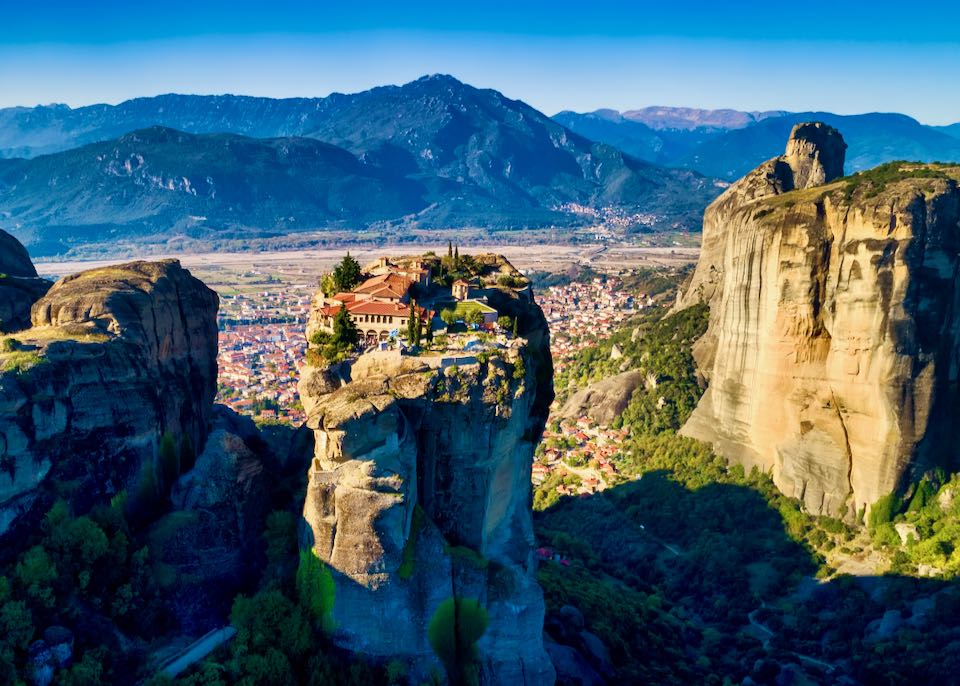
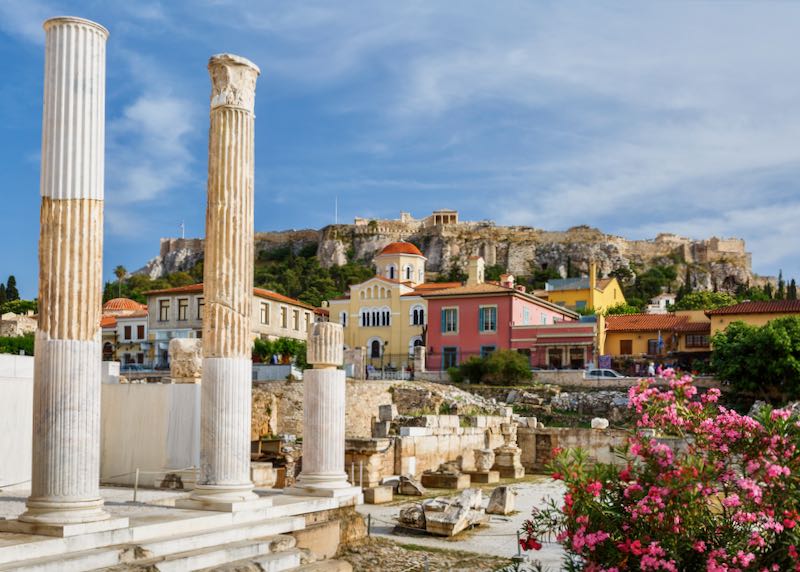
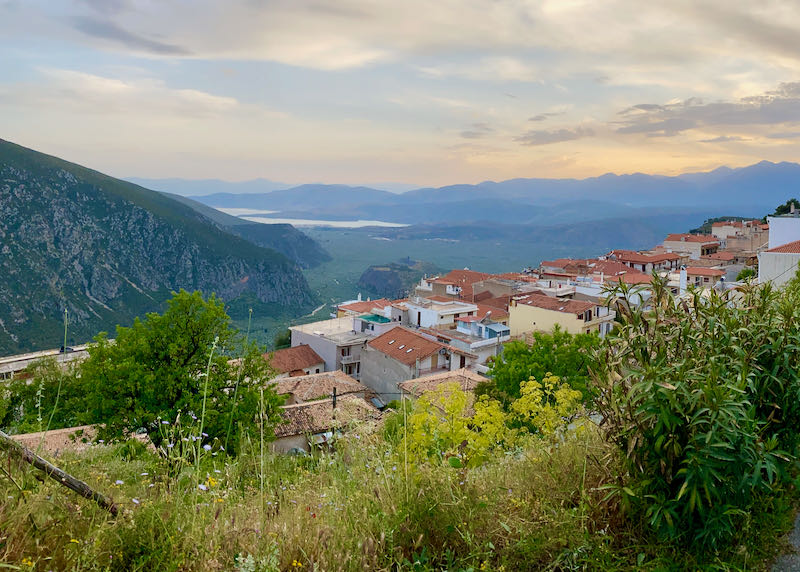
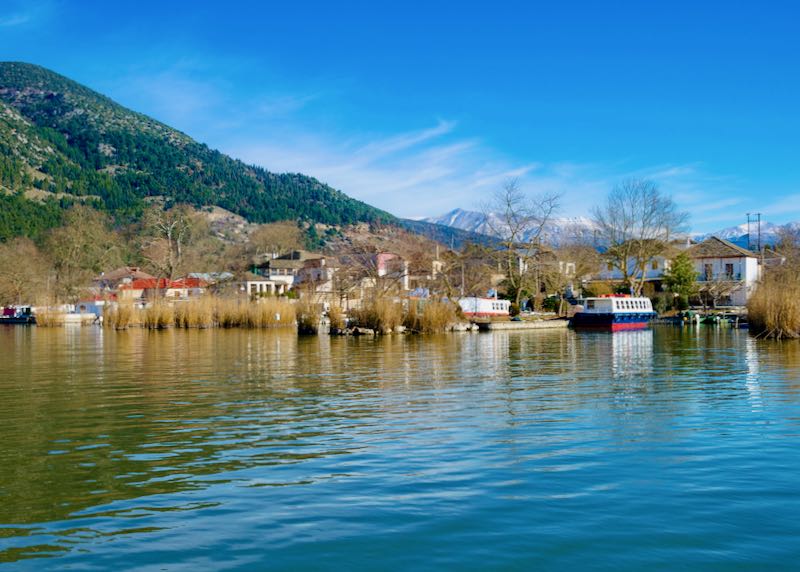
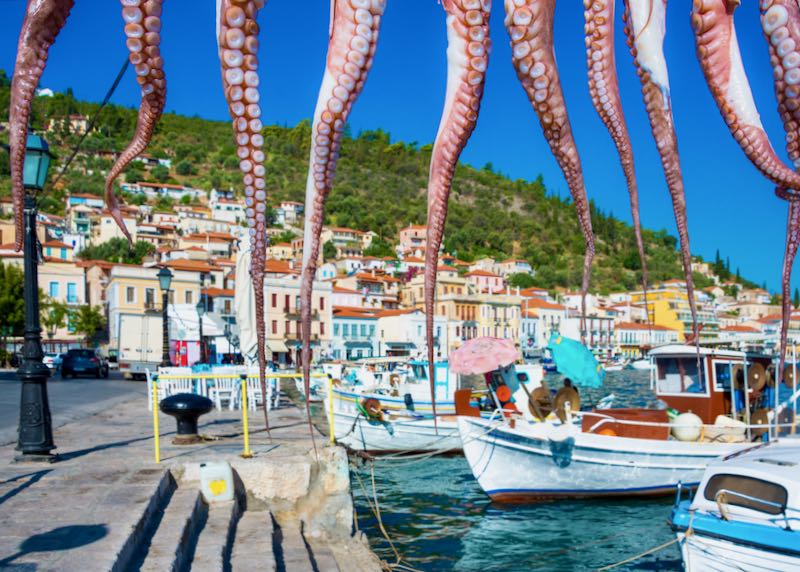
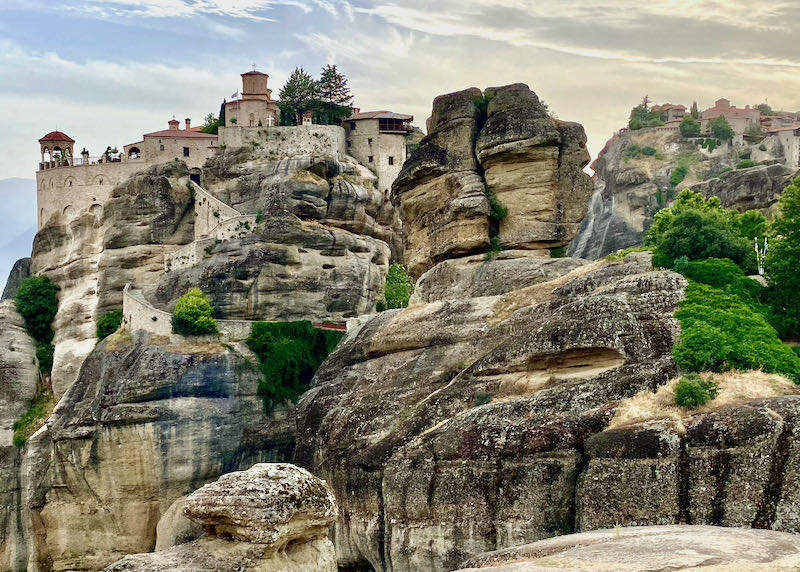
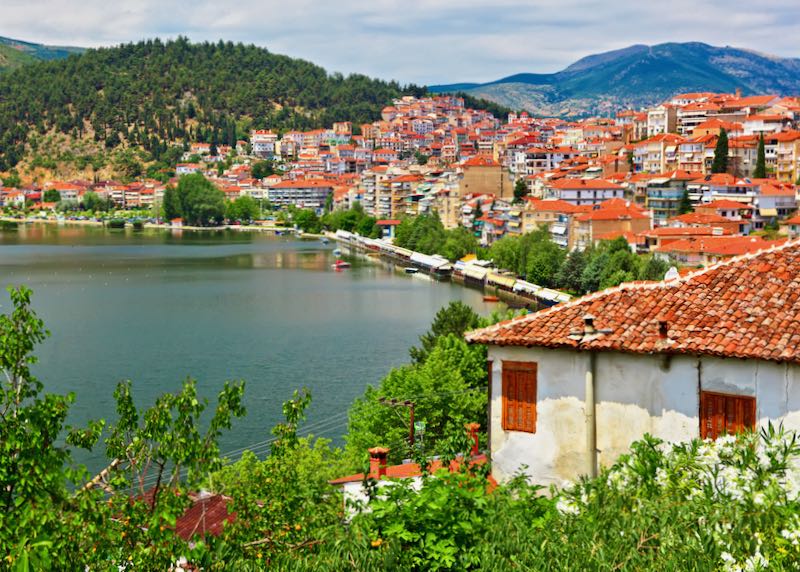
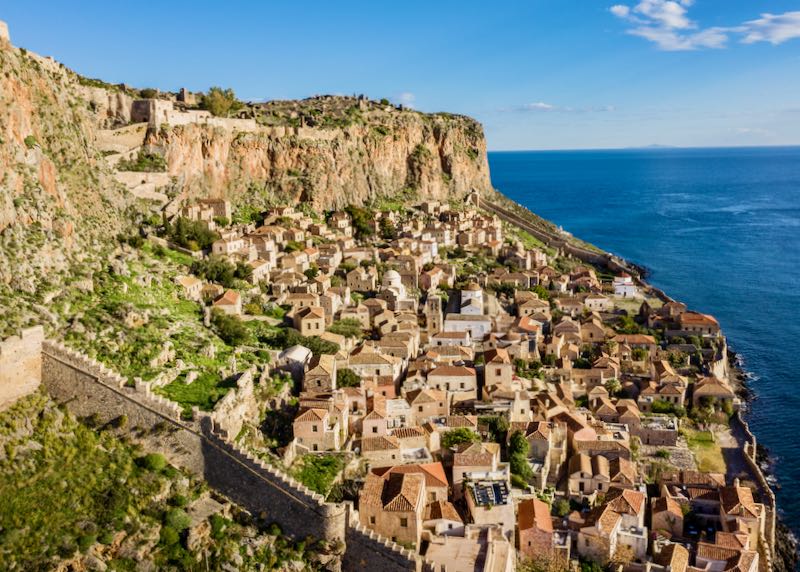
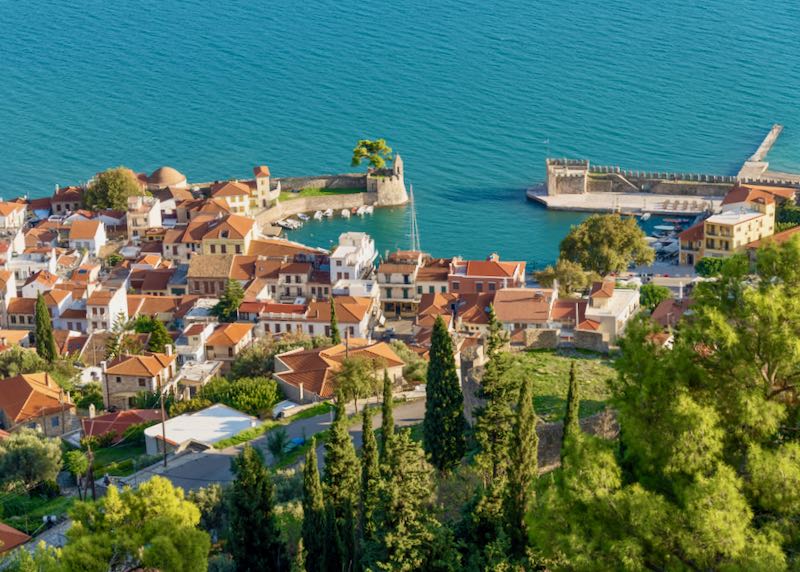
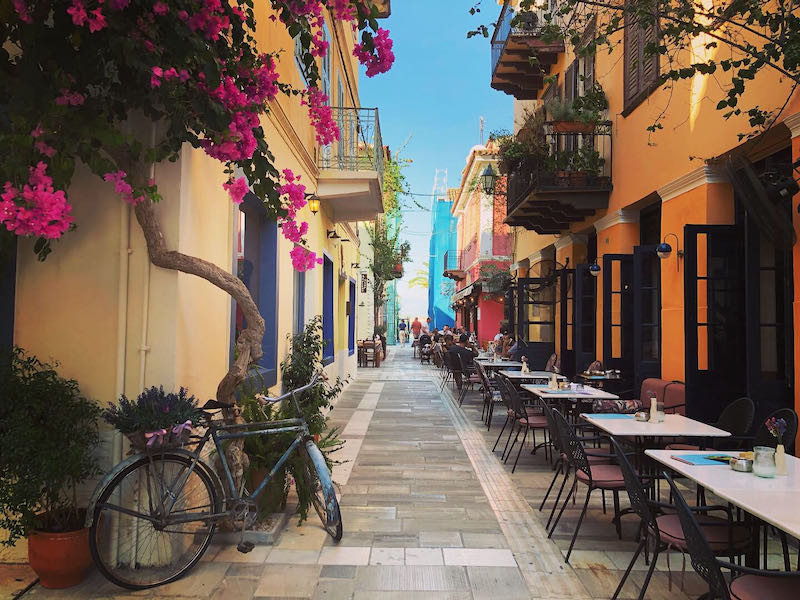
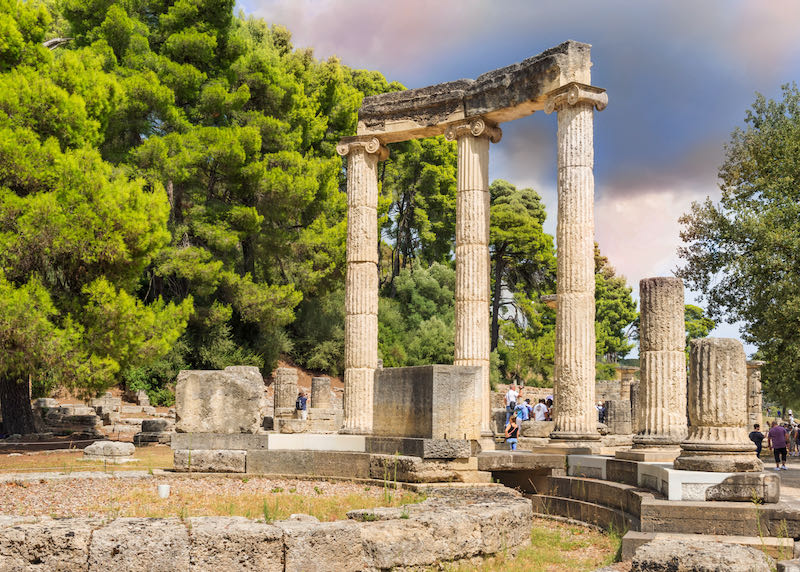
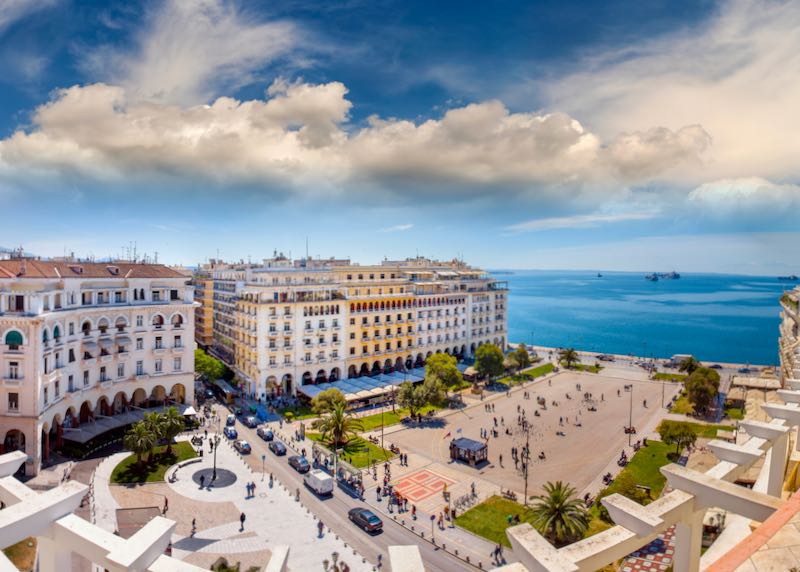
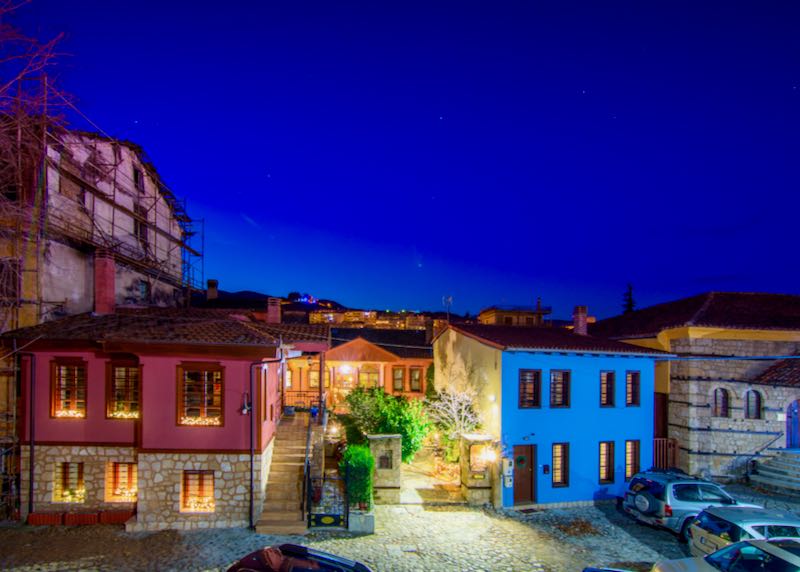
About Santorini Dave